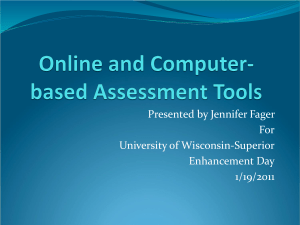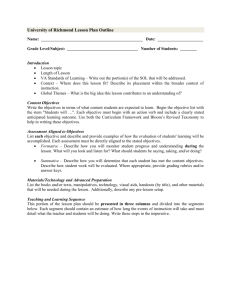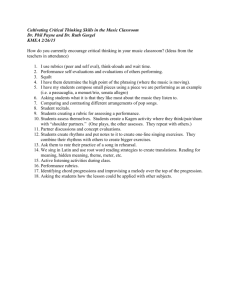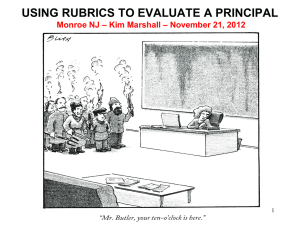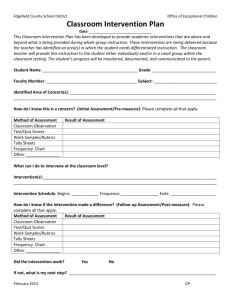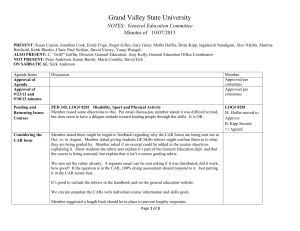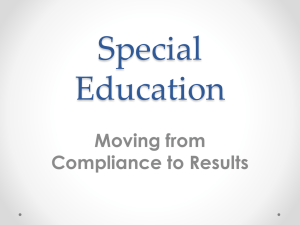edge-rubrics-jan-1-25-06
advertisement
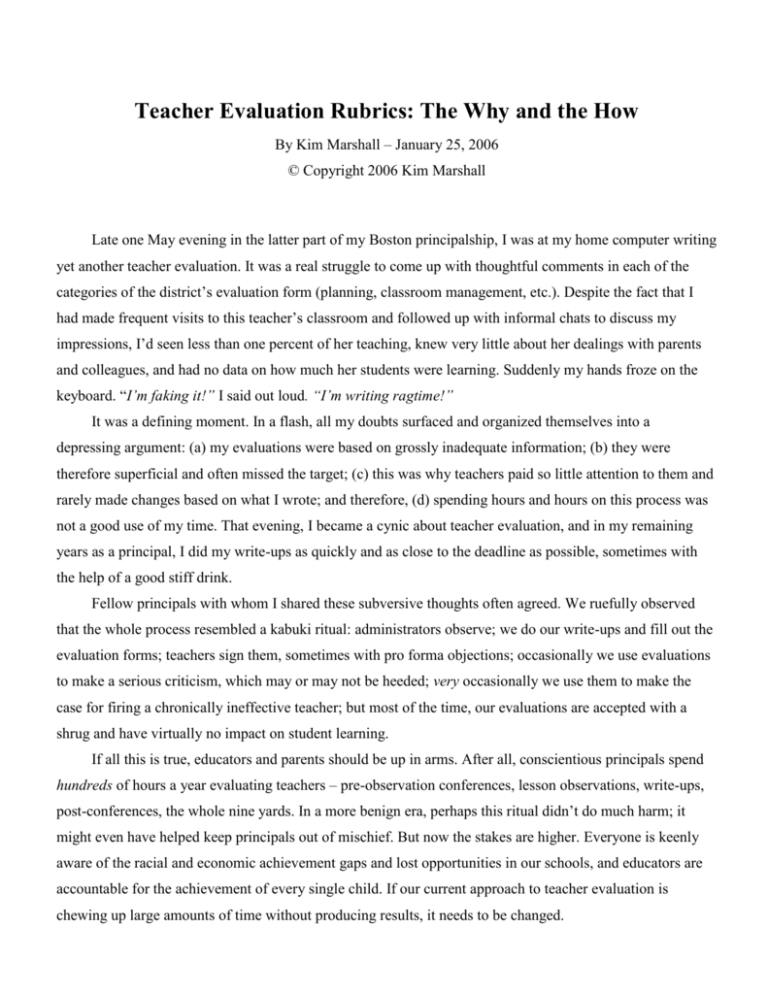
Teacher Evaluation Rubrics: The Why and the How By Kim Marshall – January 25, 2006 © Copyright 2006 Kim Marshall Late one May evening in the latter part of my Boston principalship, I was at my home computer writing yet another teacher evaluation. It was a real struggle to come up with thoughtful comments in each of the categories of the district’s evaluation form (planning, classroom management, etc.). Despite the fact that I had made frequent visits to this teacher’s classroom and followed up with informal chats to discuss my impressions, I’d seen less than one percent of her teaching, knew very little about her dealings with parents and colleagues, and had no data on how much her students were learning. Suddenly my hands froze on the keyboard. “I’m faking it!” I said out loud. “I’m writing ragtime!” It was a defining moment. In a flash, all my doubts surfaced and organized themselves into a depressing argument: (a) my evaluations were based on grossly inadequate information; (b) they were therefore superficial and often missed the target; (c) this was why teachers paid so little attention to them and rarely made changes based on what I wrote; and therefore, (d) spending hours and hours on this process was not a good use of my time. That evening, I became a cynic about teacher evaluation, and in my remaining years as a principal, I did my write-ups as quickly and as close to the deadline as possible, sometimes with the help of a good stiff drink. Fellow principals with whom I shared these subversive thoughts often agreed. We ruefully observed that the whole process resembled a kabuki ritual: administrators observe; we do our write-ups and fill out the evaluation forms; teachers sign them, sometimes with pro forma objections; occasionally we use evaluations to make a serious criticism, which may or may not be heeded; very occasionally we use them to make the case for firing a chronically ineffective teacher; but most of the time, our evaluations are accepted with a shrug and have virtually no impact on student learning. If all this is true, educators and parents should be up in arms. After all, conscientious principals spend hundreds of hours a year evaluating teachers – pre-observation conferences, lesson observations, write-ups, post-conferences, the whole nine yards. In a more benign era, perhaps this ritual didn’t do much harm; it might even have helped keep principals out of mischief. But now the stakes are higher. Everyone is keenly aware of the racial and economic achievement gaps and lost opportunities in our schools, and educators are accountable for the achievement of every single child. If our current approach to teacher evaluation is chewing up large amounts of time without producing results, it needs to be changed. But how? Over the last decade, a number of districts and charter schools have experimented with a new way of evaluating teachers – rubrics. A major source of inspiration has been Charlotte Danielson’s 1996 book, Enhancing Professional Practice: A Framework for Teaching (ASCD), which contains an extraordinarily thorough set of scoring guides. Supporters of rubrics say that this approach addresses some of the most glaring problems of conventional teacher evaluation. First, rubrics are more “judgmental,” giving teachers clearer feedback on where they stand, usually on a 4-3-2-1 scale. Second, rubrics explicitly lay out the characteristics of each level, giving mediocre and unsatisfactory teachers a road map for improving their performance. And third, rubrics are much less time-consuming for principals to complete, since lengthy narratives and lesson descriptions are not required. Great in theory. But all of the rubrics I’ve seen so far are flawed in one or more ways, and I wouldn’t be comfortable using any of them as a principal. Some, including Danielson’s, are too long and detailed to be practical in a busy school and would strike many teachers as overwhelming. Others organize teaching in illogical ways or have gaps in their analysis of pedagogy. And almost none are formatted in ways that are user-friendly. But lots of good work has been done and these flaws are fixable. This is what led me to gather the pertinent research and every available exemplar and take a crack at creating a new set of teacher evaluation rubrics. Below is a step-by-step description of how I sorted out the domains of teaching, decided on a rating scale, synthesized hundreds of criteria into compact lists of proficient teaching characteristics, and then teased the lists into six finished rubrics. I hope this description – and the rubrics – will be helpful to educators involved in rethinking teacher evaluation. You are welcome to use or modify the rubrics in any way you see fit. Step One – Deciding on Domains With any teacher evaluation instrument, the first decision is how to organize the domains of teaching. Here are a some recent categorizations: Charlotte Danielson: Enhancing Professional Practice: A Framework for Teaching (1996) 1. Planning and Preparation 2. The Classroom Environment 3. Instruction 4. Professional Responsibilities Jon Saphier’s “Parameters of Teaching” (The Skillful Teacher, RBT, 1997) a. Attention b. Momentum c. Space d. Time e. Routines f. Discipline 2 g. Clarity h. Principles of learning i. Models of teaching j. Expectations k. Personal relationships building l. Classroom climate m. Objectives n. Learning experiences o. Assessment p. Curriculum design q. Overarching objectives North Star Academy Charter School, Newark (2004) 1. Planning and Preparing Instruction 2. Classroom Management and Classroom Environment 3. Focus on Student Learning a. Engaging pedagogy b. Adapting instruction c. Assessment d. Delivering instruction 4. Concern for Students 5. Professionalism and Word Habits Boston Public Schools 2002 Revised Format 1. Knowledge of Subject Matter and Currency in the Curriculum 2. Setting the Stage for Learning 3. Classroom Management 4. Effective Teaching 5. Monitoring, Assessment, and Follow-Up 6. Professional Responsibilities Outside the Classroom: a. Collaboration with parents b. Collaboration with Colleagues c. School Responsibilities d. Professional Growth San Francisco Rubric from California Standards for the Teaching Profession (2003-04) 1. Engaging and Supporting All Students in Learning 2. Creating and Maintaining an Effective Environment for Learning 3. Understanding and Organizing Subject Matter Knowledge 4. Planning, Designing, and Delivering Learning Experiences to All Students 5. Assessing Student Learning 6. Developing as a Professional Educator Aspire Charter Schools, California (2002) 1. Commitment to Students and Learning 2. Knowledge of Subject Matter 3. Skill in the Management of Learning 4. Ability to Reflect and Improve 5. Collaboration with Colleagues, Parents, and Community Working with these and many other categorizations, I came up with a new synthesis that I think is 3 compact and yet comprehensive: A. Planning and Preparation for Learning B. Classroom Management C. Delivery of Instruction D. Monitoring, Assessment, and Follow-Up E. Family and Community Outreach F. Professional Responsibilities Step Two – Deciding on the Rating Scale Over the years, schools have used a variety of ratings, with anywhere from two to ten levels of proficiency and a wide range of descriptive labels. Recently, four-point scales have emerged as the favorite because (a) four is a simple, manageable number of levels for teachers and administrators; and (b) four is an even number, clearly differentiating between proficient and less-than-proficient performance (there’s no hiding in the middle). Here are some recently-developed scales: Charlotte Danielson (1996): 4 – Distinguished 3 – Proficient 2 – Basic 1 – Unsatisfactory Boston Public Schools Dimensions of Effective Teaching Rubric (2005): 4 – Exceeding the standard 3 – Meeting the standard 2 – Progressing toward the standard 1 – Beginning North Star Academy Charter School, Newark (2004) 4 – Advanced 3 – Proficient 2 – Working towards 1 – Needs Improvement Alexandria, Virginia (2003): 4 – Exceeds expectations 3 – Meets expectations 2 – Needs improvement 1 – Unsatisfactory Conservatory Lab Charter School, Boston (2004): 4 – Expert 3 – Proficient 2 – Developing 1 – Novice 4 The choice of labels for each level is crucial because it communicates the philosophy behind the scale – for example, using “novice” rather than “unsatisfactory” for the lowest level reflects a particular approach to less-than-satisfactory performance. Looking at a number of scales helped clarify my own theory of action. I believe that the top two levels should contain professional characteristics that research indicates will improve student achievement and narrow the racial and economic gap. I also believe teachers should be rated with respect to known standards, not compared to each other; in other words, teachers should not be “graded on a curve.” Here’s the message that I think each level should convey: • Level 4 should be reserved for teachers who are exceptionally distinguished, well above standards, truly superb. Making the top level a “high bar” cuts down on one of the perennial problems with teacher evaluation – grade inflation. • Level 3 should represent really solid professional performance – the expected norm of performance – without the slightest suggestion of mediocrity. Teachers who are performing at Level 3 should be able to hold their heads high (while still, perhaps, aspiring to reach the highest level). • Level 2 is barely “passing” and should convey the message that performance is not up to par and needs to be improved. No teacher should be comfortable with ratings at this level – it’s not a “gentleman’s C.” • Level 1 is clearly unsatisfactory, below standards, unacceptable, and headed straight toward job termination unless major improvements are made – but the label should avoid using a word that sounds terminal and inescapable. Applying this philosophy and choosing the wording very carefully, these are the labels that seemed most appropriate: 4 – Expert 3 – Proficient 2 – Needs Improvement 1 – Does Not Meet Standards Step Three – Sorting the Criteria The most difficult part of constructing rubrics is deciding on the criteria that belong in each domain and writing them in clear, succinct language. To avoid having to go back and change all four levels of a rubric if something needs to be changed, it’s a good idea to start by drafting just one level (in this case, Proficient) and doing all the writing, editing, sorting, synthesizing, sequencing, and getting feedback from critical friends before teasing the criteria to the other three levels. 5 Educators and laypeople have been coming up with lists of desirable teacher qualities from time immemorial, and there are literally thousands to choose from. The good news was that the more time I spent massaging the criteria, the more convergence I found around the bedrock principles of good teaching. Below is my synthesis: Teacher Evaluation Criteria – Proficient Level A. Planning and Preparation for Learning - Knows the subject matter well and has an up-to-date grasp of how students learn it best. - Plans the year so students will meet state standards and are prepared for external assessments. - Plans curriculum units backwards with standards and higher-order skills in mind. - Plans formative and summative assessments to measure student learning. - Anticipates misconceptions and confusions that students might have. - Designs lessons focused on measurable outcomes aligned with unit goals and state standards. - Designs lessons that are relevant, motivational, and likely to engage students in active learning. - Designs lessons that use an effective, multicultural mix of materials. - Designs lessons that break down complex tasks and target diverse learning needs, styles, and interests. - Organizes classroom furniture, materials, and displays to support unit and lesson goals. B. Classroom Management - Clearly communicates and consistently enforces high standards for student behavior. - Is fair and respectful toward students and builds positive relationships. - Commands respect and refuses to tolerate disruption. - Fosters positive interactions among students and teaches useful social skills. - Teaches routines and has students maintain them all year. - Develops students’ self-discipline and teaches them to take responsibility for their own actions. - Has a repertoire of discipline “moves” and can capture and maintain students’ attention. - Maximizes academic learning time through coherence, lesson momentum, and smooth transitions. - Is a confident, dynamic “presence” and nips most discipline problems in the bud. - Uses incentives wisely to encourage and reinforce student cooperation. C. Delivery of Instruction - Conveys to students: This is important, you can do it, and I’m not going to give up on you. - Tells students that it’s okay to take risks and make mistakes; effective effort, not innate ability, is the key. - Gives students a clear sense of purpose by posting the unit’s essential questions and the lesson’s goals. - Activates students’ prior knowledge and hooks their interest in each unit and lesson. - Uses clear explanations, appropriate language, and good examples to present material. - Orchestrates effective strategies, materials, and classroom groupings to foster student learning. - Has students actively think about, discuss, and use the ideas and skills being taught. - Differentiates and scaffolds instruction to accommodate students’ learning needs. - Is flexible about modifying lessons to take advantage of teachable moments. - Has students sum up what they have learned and apply it in a different context. D. Monitoring, Assessment, and Follow-Up - Posts clear criteria for proficiency, including rubrics and exemplars of student work. - Diagnoses students’ knowledge and skills up front and uses a variety of assessments during each unit. - Frequently checks for understanding and gives students helpful feedback if they seem confused. - Has students set goals, self-assess, and know where they stand academically at all times. 6 - Regularly posts students’ work to make visible and celebrate their progress with respect to standards. Uses data from interim assessments to adjust teaching, re-teach, and follow up with failing students. Takes responsibility for students who are not succeeding and tenaciously gives them extra help. When necessary, refers students for specialized diagnosis and extra help. Analyzes data from summative assessments, draws conclusions, and shares them appropriately. Reflects on the effectiveness of lessons and units and continuously works to improve them. E. Family and Community Outreach - Communicates respectfully with parents and is sensitive to different families’ culture and values. - Shows parents a genuine interest and belief in each child’s ability to reach standards. - Gives parents clear, succinct expectations for student learning and behavior for the year. - Promptly informs parents of behavior and learning problems, and also updates parents on good news. - Updates parents on the unfolding curriculum and suggests ways to support learning at home. - Assigns appropriate homework, holds students accountable for turning it in, and gives feedback. - Responds promptly and effectively to parent concerns and makes parents feel welcome in the classroom. - Uses conferences and report cards to give parents feedback on their children’s progress. - Tries to contact all parent and is tenacious in contacting hard-to-reach parents. - Reaches out to families and community agencies to bring in volunteers and additional resources. F. Professional Responsibilities - Has excellent attendance. - Is punctual and reliable with paperwork, duties, and assignments; keeps accurate records. - Demonstrates professional demeanor and maintains appropriate boundaries. - Is ethical and above-board, uses good judgment, and maintains confidentiality with student information. - Shares responsibility for grade-level and schoolwide activities and volunteers to serve on committees. - Is a positive team player and contributes ideas, expertise, and time to the overall mission of the school. - Keeps the administration informed about concerns and asks for help when it’s needed. - Listens thoughtfully to other viewpoints and responds constructively to suggestions and criticism. - Collaborates with colleagues to plan units, share teaching ideas, and look at student work. - Seeks out effective teaching ideas from colleagues, supervisors, workshops, reading, the Internet, etc. Step Four – Creating the Rubrics The last step was “teasing out” these teaching criteria to the other three levels – a relatively straightforward process that nonetheless required some artful wordsmithing to reflect the different gradations of performance. The six rubrics are printed in full in the pages below. What’s the best way to record ratings on these rubrics? I suggest using a highlighter, swiping the whole line that best describes the level of proficiency for each standard. I also suggest reading through all four levels of each standard (for example, 4a, 3a, 2a, 1a) before deciding which one to highlight (see rubric D for an example of how this looks). Using a highlighter produces a graphically clear picture of where the majority of the ratings fall and where performance is exceptionally good – and where it needs improvement. 7 A. Planning and Preparation for Learning The teacher: 4 - Expert a. Is an expert in the subject area and has a cutting-edge grasp about how students learn it best. b. Has a well-honed game plan for the year that is tightly aligned with state standards and assessments. c. Plans all units backwards with standards, state assessments, and higher-order skills in mind. d. Plans diagnostic, formative, and summative assessments to closely monitor student learning. e. Anticipates misconceptions that students are likely to have and plans how to overcome them. f. Designs lessons with clear, measurable goals closely aligned with standards and unit outcomes. g. Designs highly relevant lessons that will motivate all students and sweep them up in active learning. h. Designs lessons involving an appropriate mix of top-notch, multicultural learning materials. i. Designs lessons that simplify complex tasks and address all learning needs, styles, and interests. j. Artfully uses room arrangement, materials, and displays to maximize student learning of all material. 3 - Proficient a. Knows the subject matter well and has an up-to-date grasp of how students learn it best. b. Plans the year so students will meet state standards and be ready for external assessments. c. Plans most curriculum units backwards with standards and higher-order skills in mind. d. Plans formative and summative assessments to measure student learning. e. Anticipates misconceptions and confusions that students might have. f. Designs lessons focused on measurable outcomes aligned with unit goals and state standards. g. Designs lessons that are relevant, motivational, and likely to engage students in active learning. h. Designs lessons that use an effective, multicultural mix of materials. i. Designs lessons that break down complex tasks and target diverse learning needs, styles, and interests. j. Organizes classroom furniture, materials, and displays to support unit and lesson goals. 2 – Needs Improvement a. Is somewhat familiar with the subject and has a few ideas of ways students might learn it. b. Has done some thinking about how to cover state standards and test requirements this year. c. Plans lessons with some thought to larger goals and objectives. d. Drafts unit tests as instruction proceeds. e. Has a hunch about one or two ways that students might become confused with the content. f. Plans lessons with unit goals in mind. g. Plans lessons that will catch some students’ interest and perhaps get a discussion going. h. Plans lessons that involve a mixture of good and mediocre learning materials. i. Plans lessons with some thought as to how to accommodate special needs students. j. Organizes furniture and materials to support the lesson, with only a few decorative displays. 1 – Does Not Meet Standards a. Has little familiarity with the subject matter and few ideas on how to teach it. b. Plans lesson by lesson and has little familiarity with state standards and tests. c. Teaches on an ad hoc basis with little or no consideration for long-range curriculum goals. d. Writes final tests shortly before they are given. e. Proceeds without considering misconceptions that students might have about the material. f. Plans lessons aimed primarily at entertaining students or covering textbook chapters. g. Plans lessons with very little likelihood of motivating or involving students. h. Plans lessons that rely mainly on mediocre and low-quality textbooks, workbooks, or worksheets. i. Plans lessons aimed at the “middle” of the class. j. Has a conventional furniture arrangement, hard-to-access materials, and few wall displays. Overall rating: ___ Comments: 8 B. Classroom Management The teacher: 4 - Expert a. Is direct, specific, consistent, and tenacious in communicating and enforcing very high expectations. b. Shows warmth, caring, respect, and fairness for all students and builds strong relationships. c. Wins all students’ respect and creates a climate in which disruption of learning is unthinkable. d. Implements a program that successfully develops positive interactions and social-emotional skills. e. Successfully inculcates class routines so that students maintain them throughout the year. f. Successfully develops students’ self-discipline, self-confidence, and a sense of responsibility. g. Has a highly effective discipline repertoire and can capture and hold students’ attention any time. h. Uses coherence, lesson momentum, and silky-smooth transitions to get the most out of every minute. i. Is alert, poised, dynamic, and self-assured and nips virtually all discipline problems in the bud. j. Gets students to buy into a highly effective system of incentives linked to intrinsic rewards. 3 – Proficient a. Clearly communicates and consistently enforces high standards for student behavior. b. Is fair and respectful toward students and builds positive relationships. c. Commands respect and refuses to tolerate disruption. d. Fosters positive interactions among students and teaches useful social skills. e. Teaches routines and has students maintain them all year. f. Develops students’ self-discipline and teaches them to take responsibility for their own actions. g. Has a repertoire of discipline “moves” and can capture and maintain students’ attention. h. Maximizes academic learning time through coherence, lesson momentum, and smooth transitions. i. Is a confident, dynamic “presence” and nips most discipline problems in the bud. j. Uses incentives wisely to encourage and reinforce student cooperation. 2 – Needs Improvement a. Announces and posts classroom rules and punishments. b. Is fair and respectful toward most students and builds positive relationships with some. c. Wins the respect of some students but there are regular disruptions in the classroom. d. Often lectures students the need for good behavior, and makes an example of “bad” students. e. Tries to train students in class routines but many of the routines are not maintained. f. Tries to get students to be responsible for their actions, but many lack self-discipline. g. Has a limited disciplinary repertoire and students are frequently not paying attention. h. Sometimes loses teaching time due to lack of clarity, interruptions, and inefficient transitions. i. Tries to prevent discipline problems but sometimes little things escalate into big problems. j. Uses extrinsic rewards in an attempt to get students to cooperate and comply. 1 – Does Not Meet Standards a. Comes up with ad hoc rules and punishments as events unfold during the year. b. Is sometimes unfair and disrespectful to the class; plays favorites. c. Is not respected by students and the classroom is frequently chaotic and sometimes dangerous. d. Publicly berates “bad” students, blaming them for their poor behavior. e. Does not teach routines and is constantly nagging, threatening, and punishing students. f. Is unsuccessful in fostering self-discipline in students; they depend on the teacher to behave. g. Has few discipline “moves” and constantly struggles to get students’ attention. h. Loses a great deal of instructional time because of confusion, interruptions, and ragged transitions. i. Is unsuccessful at spotting and preventing discipline problems, and they frequently escalate. j. Gives away “goodies” (e.g., free time) without using it as a lever to improve behavior. Overall rating: ___ Comments: 9 C. Delivery of Instruction The teacher: 4 - Expert a. Exudes high expectations and tenacity and convinces all students that they will master the material. b. Teaches students to be risk-takers and believe that through effective effort, they will get smarter. c. Shows students exactly what’s expected by posting essential questions, rubrics, goals, and exemplars. d. Grabs students’ interest and makes connections to prior knowledge, experience, and reading. e. Presents material clearly and explicitly, makes connections, and uses vivid and appropriate language. f. Orchestrates highly effective strategies, materials, and groupings to involve and motivate students. g. Engages all students in focused work in which they are active learners and problem-solvers. h. Meets the learning needs and styles of all students by differentiating and scaffolding. i. Deftly adapts lessons and units to exploit teachable moments and correct misunderstandings. j. Has students summarize and internalize what they learn and apply it to real-life situations. 3 - Proficient a. Conveys to students: This is important, you can do it, and I’m not going to give up on you. b. Tells students it’s okay to take risks and make mistakes; effective effort, not innate ability, is the key. c. Gives students a clear sense of purpose by posting the unit’s essential questions and the lesson’s goals. d. Activates students’ prior knowledge and hooks their interest in each unit and lesson. e. Uses clear explanations, appropriate language, and good examples to present material. f. Orchestrates effective strategies, materials, and classroom groupings to foster student learning. g. Has students actively think about, discuss, and use the ideas and skills being taught. h. Differentiates and scaffolds instruction to accommodate students’ learning needs. i. Is flexible about modifying lessons to take advantage of teachable moments. j. Has students sum up what they have learned and apply it in a different context. 2 – Needs Improvement a. Tells students that the subject matter is important and they need to work hard. b. Tells students that making mistakes doesn’t mean they’re stupid, they can learn from errors. c. Tells students the main learning objectives of each lesson. d. Tries to make the subject interesting and relate it to things students already know. e. Sometimes uses language and explanations that are fuzzy, confusing, or inappropriate. f. Uses a limited range of classroom strategies, materials, and groupings with mixed success. g. Attempts to get students actively involved but some students are disengaged. h. Attempts to accommodate students with special needs, with limited success. i. Is overly focused on implementing lesson plans and sometimes misses teachable moments. j. Asks students to think about real-life applications for what they are studying. 1 - Does Not Meet Standards a. Tells students that they need to work hard to do well in school. b. Doesn’t prevent many students from feeling embarrassed when they make mistakes in school. c. Begins lessons without giving students a sense of where instruction is headed. d. Does not hook most students’ interest or make connections to their lives. e. Often presents material in a confusing way, using language that is inappropriate. f. Uses only one or two teaching strategies and types of materials and doesn’t reach most students. g. Mostly lectures to passive students or has them plod through textbooks and worksheets. h. Fails to provide for differentiated instruction for students with special needs. i. Is rigid and inflexible with lesson plans and fails to take advantage of teachable moments. j. Moves on at the end of each lesson and unit without having students summarize. Overall rating: ___ Comments: 10 D. Monitoring, Assessment, and Follow-Up The teacher: 4 - Expert a. Posts the criteria for proficient work, including rubrics and exemplars, and students internalize them. b. Uses a variety of first-rate assessments to pre-diagnose and continuously monitor students’ learning. c. Continuously checks for understanding, unscrambles confusion, and gives specific, helpful feedback. d. Has students set ambitious goals, self-assess and -monitor, and take responsibility for their progress. e. Frequently posts students’ work with rubrics and commentary and uses it to motivate and direct effort. f. Immediately uses interim assessment data to fine-tune teaching, re-teach, and help struggling students. g. Relentlessly follows up with struggling students with time and support to reach proficiency. h. Makes sure that students who need specialized diagnosis and help receive appropriate services ASAP. i. Charts and analyzes assessment data, draws action conclusions, and shares them with others. j. Constantly reflects on the effectiveness of teaching and works every day to improve. 3 - Proficient a. Posts clear criteria for proficiency, including rubrics and exemplars of student work. b. Diagnoses students’ knowledge and skills up front and uses a variety of assessments during each unit. c. Frequently checks for understanding and gives students helpful feedback if they seem confused. d. Has students set goals, self-assess, and know where they stand academically at all times. e. Regularly posts students’ work to make visible and celebrate their progress with respect to standards. f. Uses data from interim assessments to adjust teaching, re-teach, and follow up with failing students. g. Takes responsibility for students who are not succeeding and tenaciously gives them extra help. h. When necessary, refers students for specialized diagnosis and extra help. i. Analyzes data from summative assessments, draws conclusions, and shares them appropriately. j. Reflects on the effectiveness of lessons and units and continuously works to improve them. 2 – Needs Improvement a. Tells students some of the qualities that their finished work should exhibit. b. Uses pencil-and-paper quizzes and tests with some open-ended questions to assess student learning. c. Asks questions to see if students understand. d. Urges students to look over their tests, see where they had trouble, and aim to improve those areas. e. Posts some ‘A’ student work as an example others. f. Looks over students’ tests to see if there is anything that needs to be re-taught. g. Offers students who fail tests some additional time to study and do re-takes. h. Sometimes doesn’t refer students promptly for special help, or refers students who don’t need it. i. Records students’ grades and notices some general patterns for future reference. j. At the end of a teaching unit or semester, thinks about what might have been done better. 1 - Does Not Meet Standards a. Expects students to know (or figure out) what it takes to get good grades. b. Uses only multiple-choice and short-answer pencil-and-paper tests to assess student learning. c. Rarely takes time to check for understanding. d. Urges students to work harder and be more careful on future tests. e. Posts only a few samples of ‘A’ work. f. Looks over unit and final tests to see if there are any lessons for the future. g. Tells students that if they fail a test, that’s it; the class has to move on to cover the curriculum. h. Either fails to refer students for special education or refers students who do not need it. i. Records students’ grades and moves on with the curriculum. j. When a teaching unit or lesson doesn’t go well, chalks it up to experience. Overall rating: ___ Comments: 11 E. Family and Community Outreach The teacher: 4 - Expert a. Shows great sensitivity and respect for family and community culture, values, and beliefs. b. Shows each parent an in-depth knowledge of their child and a strong belief he/she will reach standards. c. Gives parents clear, user-friendly learning/behavior expectations and exemplars of proficient work. d. Makes sure parents hear positive news about their children first, and immediately flags any problems. e. Frequently involves parents in supporting and enriching the curriculum as it unfolds. f. Assigns highly-engaging homework, gets close to a 100% return, and provides rich feedback. g. Deals immediately and successfully with parent concerns and makes parents feel welcome any time. h. In conferences, report cards, and informal talks, gives parents detailed feedback on children’s progress. i. Is successful in contacting and working with all parents, including those who are hard to reach. j. Successfully enlists classroom volunteers and extra resources from homes and the community. 3 - Proficient a. Communicates respectfully with parents and is sensitive to different families’ culture and values. b. Shows parents a genuine interest and belief in each child’s ability to reach standards. c. Gives parents clear, succinct expectations for student learning and behavior for the year. d. Promptly informs parents of behavior and learning problems, and also updates parents on good news. e. Updates parents on the unfolding curriculum and suggests ways to support learning at home. f. Assigns appropriate homework, holds students accountable for turning it in, and gives feedback. g. Responds promptly and effectively to parent concerns and makes parents feel welcome in the school. h. Uses conferences and report cards to give parents feedback on their children’s progress. i. Tries to contact all parents and is tenacious in contacting hard-to-reach parents. j. Reaches out to families and community agencies to bring in volunteers and additional resources. 2 – Needs Improvement a. Tries to be sensitive to the culture and beliefs of students’ families but sometimes has a tin ear. b. Tells parents that he or she cares about their children and wants the best for them. c. Sends home a list of classroom rules and the syllabus for the year. d. Lets parents know about problems their children are having but rarely mentions positive news. e. Sends home occasional suggestions on how parents can help their children with schoolwork. f. Assigns homework and urges parents to get their children to complete it. g. Is slow to respond to some parent concerns and gives off an unwelcoming vibe. h. Uses report card conferences to tell parents the areas in which their children can improve. i. Tries to contact all parents, but ends up talking mainly to the parents of high-achieving students. j. Asks parents to volunteer in the classroom and contribute extra resources. 1 - Does Not Meet Standards a. Is often insensitive to the culture and beliefs of students’ families. b. Does not communicate to parents knowledge of individual children or concern about their future. c. Does not share learning and behavior expectations with parents. d. Seldom informs parents of concerns or positive news about their children. e. Rarely if ever communicates with parents on ways to help their children at home. f. Assigns homework but is resigned to the fact that many students won’t turn it in. g. Does not respond to parent concerns and makes parents feel unwelcome in the classroom. h. Gives out report cards and expects parents to follow up on areas that need improvement. i. Makes little or no effort to contact parents. j. Does not reach out for extra support from parents or the community. Overall rating: ____ Comments: 12 F. Professional Responsibilities The teacher: 4 - Expert a. Has perfect or near-perfect attendance. b. Carries out assignments conscientiously and punctually, keeps meticulous records, and is never late. c. Presents as a consummate professional and always observes appropriate boundaries. d. Is invariably ethical, honest, and above-board, uses impeccable judgment, and respects confidentiality. e. Is an important member of teacher teams and committees and frequently attends after-school activities. f. Frequently contributes valuable ideas and expertise that further the school’s mission. g. Informs the administration of any concerns and reaches out for help and suggestions when needed. h. Actively seeks out feedback and suggestions and uses them to improve performance. i. Meets at least weekly with colleagues to plan units, share ideas, and analyze interim assessments. j. Devours effective practices from fellow professionals, workshops, reading, study groups, the Web, etc. 3 - Proficient a. Has excellent attendance. b. Is punctual and reliable with paperwork, duties, and assignments; keeps accurate records. c. Demonstrates professional demeanor and maintains appropriate boundaries. d. Is ethical and above-board, uses good judgment, and maintains confidentiality with student records. e. Shares responsibility for grade-level and schoolwide activities and volunteers to serve on committees. f. Is a positive team player and contributes ideas, expertise, and time to the overall mission of the school. g. Keeps the administration informed about concerns and asks for help when it’s needed. h. Listens thoughtfully to other viewpoints and responds constructively to suggestions and criticism. i. Collaborates with colleagues to plan units, share teaching ideas, and look at student work. j. Seeks out effective teaching ideas from supervisors, colleagues, workshops, reading, the Internet, etc. 2 – Needs Improvement a. Has mediocre attendance. b. Occasionally skips assignments, is late, makes errors in records, and misses paperwork deadlines. c. Occasionally acts and/or dresses in an unprofessional manner and violates boundaries. d. Sometimes uses bad judgment, is less than completely honest, and discloses student information. e. Will serve on a committee and attend an after-school activities when asked to do so. f. Occasionally suggests an idea aimed at improving the school. g. Is reluctant to share concerns with the administration or ask for help. h. Is somewhat defensive but does listen to feedback and suggestions. i. Meets occasionally with colleagues to share ideas about teaching and students. j. Keeps an eye out for new ideas for improving teaching and learning. 1 - Does Not Meet Standards a. Has poor attendance. b. Frequently skips assignments, is late, makes errors in records, and misses paperwork deadlines. c. Frequently acts and/or dresses in an unprofessional manner and violates boundaries. d. Acts in an ethically questionable manner, uses poor judgment, and/or discloses student information. e. Declines invitations to serve on committees and attend after-school activities. f. Rarely if ever contributes ideas that might help improve the school. g. Bottles up concerns or constantly complains, and is not open to help. h. Is very defensive about criticism and resistant to changing classroom practice. i. Meets infrequently with colleagues, and conversations lack educational substance. j. Is not open to ideas for improving teaching and learning. Overall rating: ___ Comments: 13 Evaluation Summary Page Teacher’s name: _________________________________ School year: ________________ School: ________________________________________ Subject area: ____________________ Evaluator: ______________________________ RATINGS ON INDIVIDUAL RUBRICS: A. Planning and Preparation for Learning: Expert Proficient Needs Improvement B. Classroom Management: C. Delivery of Instruction: Expert Expert Does Not Meet Standards Proficient Proficient Needs Improvement Needs Improvement Does Not Meet Standards Does Not Meet Standards D. Monitoring, Assessment, and Follow-Up: Expert Proficient Needs Improvement E. Family and Community Outreach: F. Professional Responsibilities: OVERALL RATING: Expert Does Not Meet Standards Expert Proficient Needs Improvement Does Not Meet Standards Expert Proficient Proficient Needs Improvement Needs Improvement Does Not Meet Standards Does Not Meet Standards OVERALL COMMENTS BY PRINCIPAL: OVERALL COMMENTS BY TEACHER: Principal’s signature: ______________________________ Date: ___________ Teacher’s signature: _______________________________ Date: ___________ (The teacher’s signature indicates that he or she has seen and discussed the evaluation; it does not necessarily denote agreement with the report.) 14 Suggestions for Implementation These rubrics cover every aspect of a teacher’s professional work and are designed for summative, end-of-the-year evaluation. To do a good job filling out such comprehensive rubrics, a principal needs to gather a huge amount of information on each teacher. How is this possible? One approach that won’t work is trying to complete the rubrics based on one or two lesson observations. Rubrics are not checklists for clinical supervision or walkthroughs. They are best used to pull together all the impressions gathered in the course of a school year. If their rubric scores to be credible, principals need to be in classrooms, corridors, team meetings, and other school events on a daily basis. I think the best way to make a fair appraisal of classroom performance – and to give teachers interim feedback as the year progresses (no surprises, no excuses) – is for the principal to do frequent, unannounced five- to fifteen-minute “mini-observations” (3-5 a day) with face-to-face follow-up conversations on each visit within 24 hours. For a detailed description of this approach, which I used for seven years as a principal in Boston, see my January 1996, May 2003, and June 2005 Phi Delta Kappan articles. But even if principals are in each teacher’s classrooms every week or so, follow up after every visit, and watch teachers interact with colleagues and parents week in and week out, there’s still a lot they don’t see. A good strategy for broadening the supervisory window and improving the quality of evaluation conferences is for teachers to do a self-assessment shortly before evaluation time. If the teacher and principal both fill out the rubrics using the highlighter approach, then put each page side by side, they can compare their ratings and debate the rationale for each one (“Come on, you’re being way too hard on yourself there!” “Well, what’s the evidence for that Expert rating?”). The principal decides the final scores, but evaluations will be fairer and more credible if teachers have substantive input – and the principal really listens. When a teacher receives low ratings, how should the principal follow up? At the Needs Improvement level, teachers might be encouraged (or required) to set goals in those areas for the following year. An additional page might be added to the evaluation packet with a format for writing SMART goals (Specific, Measurable, Attainable, Results-oriented, and Time-bound). Teachers performing at the Does Not Meet Standards level need to get a formal heads-up on the areas that need improvement well before the end of the year. This is the one situation where the rubrics should be used during the year, following steps like these: (a) the principal does an interim evaluation using the full set of rubrics; (b) the principal writes a diagnosis and prescription with specific recommendations and/or mandates for remedial action, for example, attending a workshop on classroom management, visiting colleagues’ classrooms, or working with a literacy coach; (c) the principal gives the teacher a specified amount of time to improve (usually a month), and then returns for a second interim evaluation; (d) this cycle is repeated with the teacher getting clear direction and support each time; and (e) if the teacher still does not meet standards after a designated number of cycles, he or she is dismissed. (Exact procedures and an appeal 15 process need to be worked out with the district’s or school’s legal counsel, as should the question of whether some of the six domains should carry more weight in dismissal decisions, for example, classroom management and delivery of instruction.) Providing struggling teachers with a detailed diagnosis and prescription and a chance to improve is an important ethical and legal responsibility. It’s also very time-consuming. Principals in this mode have no choice but to spend a good deal of time visiting the teacher’s classroom, conferring and supporting, and writing recommendations and evaluations. In situations like this, using rubrics probably won’t save the administrator much time compared to conventional evaluation instruments. But for teachers performing at Levels 2, 3, and 4, rubrics are much less onerous. For principals thinking about introducing evaluation rubrics to teachers, here’s a suggestion. At first blush, the full set of six rubrics can seem quite daunting. You might want to introduce them the way they are rolled out in this article: explain how the six domains were decided, the rationale behind the rating scale, the 60 criteria for proficient teaching, and finally how those were teased out to create the rubrics. In charter and private schools, principals might also want to ask teachers to make suggestions for tweaking the rubrics, which would foster a greater degree of ownership. Fostering Learning Why is student achievement not included of these rubrics? After all, learning is the “bottom line” of teaching. I have studied the pros and cons of including learning data in the teacher evaluation process and see five problems: • Summative student achievement data, including standardized test scores, are rarely available in May, which is when teacher evaluations typically need to be completed. • Even if test results were available in May, assessment experts agree that they are not a fair way to measure teacher effectiveness – and this includes sophisticated “value-added” analyses. [footnote articles] • Classroom assessments of student learning, including pre- and post-tests and portfolios, are all controlled by the teacher being evaluated. Most teachers act professionally, but when the stakes are high, it’s inevitable that some (especially those with the most to lose) will distort the data. • Several categories of teachers (art and music among others) would find it difficult to produce objective evidence of student learning, so how are they to be evaluated? • Making student learning part of teacher evaluation is likely to undermine the kind of collegiality and open dialogue within teacher teams, and between teachers and administrators, that is vital to producing gains in achievement. If student results are part of the evaluation process, teachers are likely to tense up and refrain from taking risks and sharing ideas with their colleagues – and would therefore teach less effectively. 16 These concerns suggest that teacher evaluation is not the best place for administrators to address student learning results. A better strategy is for principals to work to create a “professional learning community,” holding teachers accountable for the key processes needed to make that happen. Principals have the power to orchestrate and monitor a dynamic wherein teacher teams work toward common curriculum goals, give frequent interim assessments (perhaps every nine weeks), and use the data to continuously improve their teaching and help struggling students. Research strongly suggests that this process is the “engine” that improves student achievement and narrows racial and economic gaps. I believe the engine will run most smoothly and powerfully in a low-stakes environment, with teacher teams acting as the main drivers of the data-driven improvement process. [footnote my June 2005 Kappan article] If principals are constantly in and out of classrooms, confer with teachers and teacher teams about interim learning results, and provide support, encouragement, and occasional redirection – and if they evaluate teachers each year on the rubric criteria that relate to professional learning community (Ad, Af, Df, Di, Dj, Fe, Ff, Fh, Fi, and Fj) – it’s far more likely that the supervisory “voice” will be installed inside teachers’ heads, leading them to constantly monitor and improve their performance in the 99%-plus of the school day when the principal is not around. Conclusion Thinking back to my “ragtime” moment and its aftermath, I remember how uncomfortable I was with the cynical mode I lapsed into, and how deeply I resented the hours I spent writing teacher evaluations that I believed were not making a difference. I needed a process that forced me to cut to the chase and give teachers clear, specific, and helpful feedback with as little paperwork as possible. And I needed the time and the energy to shift the conversation in our school to the heart of the matter – what was being taught, whether students were learning, and how we could improve every day. I wish I’d been able to use teacher evaluation rubrics, because I think they would have helped make that shift. I envy principals who can use evaluation rubrics today. To be sure, rubrics are a relatively new phenomenon. We don’t know how they will be received by districts, teachers, and unions across the country, nor do we have long-term data on their impact on student achievement. But the prospects for positive impact on teaching and learning seem excellent. Well-constructed rubrics lay out the standards for teaching excellence so that everyone knows what it takes to be proficient. Rubrics give teachers detailed information on where they stand and provide clear direction for improvement. Most important, rubrics allow principals to spend less time trying to document the process of teaching so they can spend more time focusing on results – and on getting the “engine of improvement” running in their schools. This is what’s needed if we are to build professional learning communities in our schools and bring all of our students to high levels of achievement. 17 Sources The author wishes to thank Pete Turnamian, Mark Jacobson, Andy Platt, and Jon Saphier for valuable suggestions. Bibliography: A Framework for Leading Learning (unknown source) Alexandria Public Schools (Virginia) performance evaluation rubrics (2003) Aspire Charter Schools, California teacher evaluation rubrics Boston Public Schools Performance Evaluation Instrument (1997) City on a Hill Charter School (Boston) performance evaluation rubrics (2004) Conservatory Lab Charter School (Boston) performance evaluation rubrics (2004) Enhancing Professional Practice: A Framework for Teaching by Charlotte Danielson (ASCD, 1996) “Indicators of Teaching for Understanding” by Jay McTighe and Eliot Seif (unpublished paper, 2005) Linking Teacher Evaluation and Student Learning by Pamela Tucker and James Stronge (ASCD, 2005) North Star Academy Charter School of Newark: Teaching Standards (2004-05) Roxbury Preparatory Charter School, Boston: Criteria for Outstanding Teaching (2004-05) The Skillful Teacher by Jon Saphier and Robert Gower (Research for Better Teaching, 1997) The Three Big Rocks of Educational Reform by Jon Saphier (Research for Better Teaching, 2005) Vaughn Next Century Learning Center, Chicago performance evaluation rubric (2004) What Works in Schools: Translating Research into Action by Robert Marzano (ASCD, 2003) Kim Marshall was a teacher, central office administrator, and principal in the Boston Public Schools for 32 years. He is now a leadership coach for new principals and publishes the Marshall Memo, a weekly newsletter summarizing practical educational research (www.marshallmemo.com). 18
